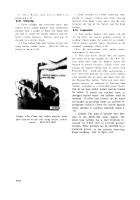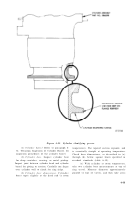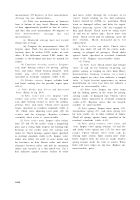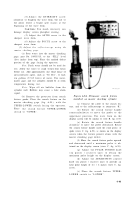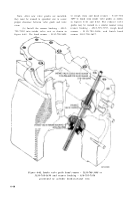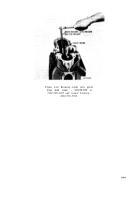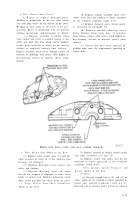TM-9-2815-200-35
ENGINE, WITH CONTAINER:TURBOSUPERCHARGED, DIESEL ,FUEL INJECTION ,90-DEGREE “V” TYPE, AIR - COOLED ,12 - CYLINDER , ASSEMBLY ;MODELS AVDS-1790-2M (2815-856-4996), AVDS-1790-2A AND AVDS-1790-2AM (2815-856-9005)
TECHNICAL MANUAL; DIRECT SUPPORT, GENERAL SUPPORT AND DEPOT MAINTENANCE MANUAL INCLUDING REPAIR PARTS AND SPECIAL TOOLS LISTS
TM-9-2815-200-35 - Page 358 of 779
(j) Turn the SYNC switch (on transigate)
to MAIN PULSE, and the GATE OFF switch
on.
(k) Turn the START knob (on trans -
igate) to “2”. Adjust the START VERNIE R
knob so that a downward jog is in line with the
7th from the left vertical scale line on the display
screen. Place the search fixture UPPER -
LOWER switch to “UPPER” .
(l) Turn the LENGTH knob (on trans-
igate) to “1“. Adjust the LENGTH VERNIE R
knob to end the gate at the right hand edge of the
flaw signal (approximately 9-1 / 2 vertical scale
lines from the left of display screen).
(m) Adjust the VERT screw to place the
lower gate line over the zero horizontal scale line
on display screen.
(n) Adjust the FOCUS and ASTIG knobs
for the sharpest wave form.
(0) Adjust the SENSITIVITY contro l
knob (Pulser / receiver unit) until the echo pulse
measures 2-1 / 2 inches high on the display
screen (view D, fig. 6-53).
(p)
Tur n
th e
REJECT kno b
(pulser / receiver unit) clockwise to the reduce
the echo pulse height to 1 inch (view E, fig. 6-
53).
(q) Turn the ALARM LEVEL knob (on
transigate) to + AUTO RESET. Rotate th e
ALARM LEVEL vernier knob clockwise, then
counterclockwise until the light just appears on
RESET button. Place the AUDIO switch t o
“ON” and the alarm will sound (buzz).
(r)
Turn
the
REJECT knob (o n
pulser / receiver unit) counterclockwise to
“OFF”. The echo pulse height will then return to
2-1 / 2 inches (view D, fig. 6-53).
(
S
) Continue clockwise rotation of the
search until handle until a heavy echo reflection
enters the gate (view F, fig. 6-53). The heavy
reflection indicates that the search fixture probe
has reached the maximum downward travel. The
cylinder barrel tester is now adjusted to establish
the wave form.
(t) Turn the POWER KNOB to “OFF”.
Disconnect cable and remove the search fixture
from the master checking gage. Install probe
protector and reflectoscope cover. Pour water
from checking gage.
e. Establish the Wave From on the Reflec-.
toscope Display Screen for Daily Operation.
(1) Preliminary calitiration.
(a) Remove the reflectoscope cover.
(b) Plug the reflectoscope into a 115 volt
10 volt, 50 / 60 cycle single phase power
source. Turn the POWER (SCALE ILLUM )
knob clockwise and allow time for warm-up.
(c) Turn the POWER (SCALE ILLUM)
knob counterclockwise, but not to “OFF”.
(d) Turn the SENSITIVITY contro l
knob to “l”, an d the REJECT knob to “OFF”.
(e) The wave form on the display screen
should be similar to view G, fig. 6-53.
Note.
Should the wave form not appear,
or is markedly different than that shown in view
G, figure 6-53, recalibrate the tester in ac-
cordance with the instructions in paragraph d,
above.
(f) Pour water into the master checking
gage to the “FILL” level (five inches from top),
refer to paragraph d (3) (a). Place the marked
defect portion of the gage facing the operator.
Note.
Wipe all air bubbles from th e
cylinder wall. Bubbles may cause a false alarm
signal.
(g) Remove the protector from the search
fixture probe.
Place the search fixture in the
master checking gage with the fixture flange
resting on the cylinder mounting flange. Move
the probe to the top of its travel and place the
fixture UPPER-LOWER switch to “UPPER” .
(h) Connect the cable to the search fixture
and the reflectoscope at connector “R”. The
wave form on the display screen will be similar to
view H, fig. 6-53.
(i) Rotate the search fixture handle clock-
wise to move the probe downward. Rotate the
search fixture handle until the echo pulse, or
spike (view D, fig. 6-53) is shown on the display
screen when the fixture pointer alines with the
defect on the master checking gage.
(j) Rotate the search fixture handle to
move probe slightly upward and downward until
a maximum pulse is seen on the display screen.
(k) Adjust the SENSITIVITY contro l
knob to probe an echo pulse height of 2-1 /
2
inches (view I, fig. 6-53).
(l) Turn the REJECT knob clockwise to
reduce the echo pulse height to 1 inch.
(m) Turn the ALARM LEVEL knob (on
transigate) to + AUTO RESET. Rotate th e
ALARM LEVEL vernier knob until the light
just appears on RESET button. The alarm will
sound (buzz) when the AUDIO switch is “ON”.
6-64
Back to Top

